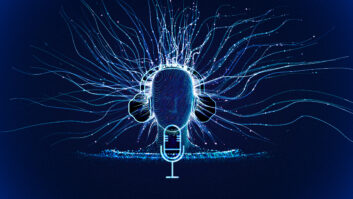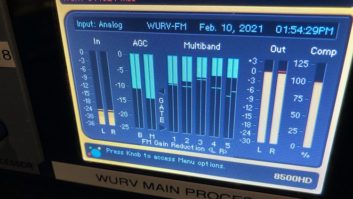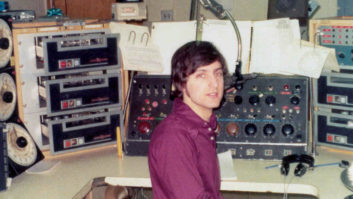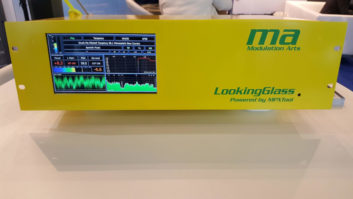Jeff Loughridge is the market engineer for Infinity in Washington. He and his staff are the guys who had fun installing a brass pole for hiding wiring in the Sports Junkies studio (See the May 21, Workbench).
They’re always thinking about solving problems. After a recent LED beacon SBE presentation by Dialight, Jeff and team “borrowed” the beacon for a day and hooked it up as a “time to break” warning light for the Junkies the next morning. It seems the small red warning light was being ignored by the air talent when it flashed to signal “time to break.”
The next morning, when it was time for the first break, the producer hit the warning light and the studio was bathed in red as the beacon came to life. One of the Junkies remarked the light could probably be seen in Florida.
(click thumbnail)Fig. 1: LEDtronics StripLED Connectable LED Modules
(click thumbnail)Fig. 2: Garden hose hangers are good for hanging coaxial test cables.
(click thumbnail)Fig. 3: The hangers prevent the cables from developing flat spots or kinks.
(click thumbnail)Fig. 4: A cable tie through a “stick-on” tie clamp holds the cord from a wall-wart into a piece of equipment.
To keep OSHA happy, the beacon was placed high on a shelf, so no one was in the direct beam of the light. If you saw the beacon demonstrated at the NAB show, you can attest to how efficient Dialight has gotten its LED product. It’s the only LED tower light product that has been FAA-approved.
Now, LEDtronics is out with StripLED Connectable LED Modules. These modules, shown in Fig. 1, can be used for signs, or displays, making it possible to configure your own “shut up, it’s time to break” studio sign, without resorting to a tower beacon.
The LED modules are wired in parallel and function independently. Just like the beacon, if one LED fails, the others continue to operate. With an average life span of 11 years, the LED modules operate more than 20 times longer than incandescents.
Another advantage is that LED lamps produce almost no heat and require substantially less operating power than their equivalent incandescents. It’s only a matter of time before LEDs take Las Vegas by storm, being so environmentally and budget friendly.
The StripLED Connectable LED modules range from $2.75 to $3.80 each. Find out more by visiting the www.ledtronics.com, or call (800) 579-4875 and request Data Sheet Log 157.
Reginald Swedberg is chief of KJNP(AM-FM) at North Pole, Alaska.
He and Jeff Turkel provided photos (Figs. 2 and 3) that show traditional garden hose hangers as a great way to hang coaxial test cables. The hangers are cheap and easy to obtain; they prevent the cables from developing flat spots or kinks as would occur if the cables were hung on a nail.
Hose hangers also permit the cables to be spread out, so selection is easier than if they are coiled on a shelf.
Reginald has expanded their use to hold extension cords either in the transmitter building or in a garage or shop at home. E-mail him at [email protected].




. . .
If you’re with a state or national network, or do a lot of satellite work, SatFinder may be of interest. It is a CD-ROM with a database and calculation functions.
It contains details on thousands of satellite industry companies, as well as data on all satellite systems worldwide including frequencies, bandwidths, power levels and users.
A 25,000-city database makes link budgeting, site surveying and other calculations a breeze. You can design your satellite requirements for any global location.
The CD-ROM service is updated quarterly. For information, visit www.satnews.com/free/findinfo.html .
. . .
Having plugs fall out of critical pieces of equipment can be an engineer’s nightmare. Expecting air talent to root around behind a rack only compounds the problem.
John Huntley, chief at WEVN(FM) and the New Hampshire Public Radio Network, shares a simple, effective solution. Fig. 4 shows a cable tie through a “stick-on” cable tie clamp, which holds the cord from a wall-wart into a Sage Endec, in this example. This type of cable restraint can be used on virtually any equipment.
Note that John has left enough slack that the plug can be removed, if need be.
This type of cable restraint also works well with IEC AC power cords, and is useful not only in the studio, but also at the transmitter. Hopefully John’s tip will eliminate at least some of those “late night” calls, and in the case of remote equipment, prevent those panicked calls that the remote gear isn’t working. Reach him at [email protected].
Submissions for this column are encouraged and qualify for SBE recertification credit. Fax your submission to (703) 323-8044, or send e-mail to [email protected]












